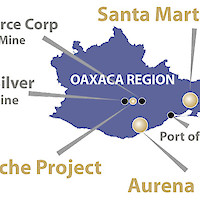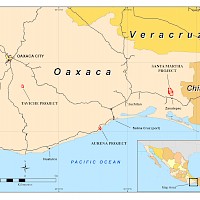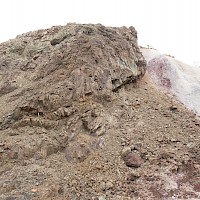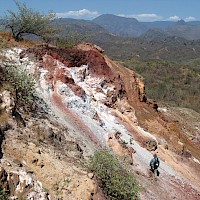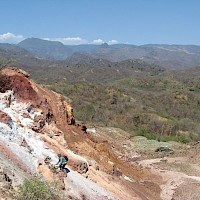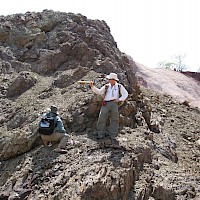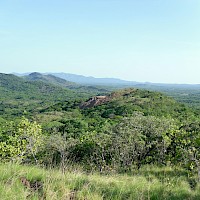Santa Marta
Project
Santa Marta
Commodity
Copper, Gold
Location
Eastern Oaxaca
Nearest City
10 km from city of Zanatepec
125 km from major port of Salina Cruz
Nearest Major Mining Projects
Fortuna Silver’s San Jose Mine
Gold Resource’s El Aguila Mine
Development Stage
Drill permits submitted
Geology
VMS
Exploration Highlights
Sampling: 1.1% copper over 25 meters in oxidized rock in old pit. A silica-rich horizon, interpreted as a volcanic-exhalative lens, assayed 0.8 to 1.0 g/t gold across sample widths of up to 4 meters
Land Package
6,410 has
Access & Infrastructure
Gravel roads, power, water
Project
Santa Marta is a copper-gold project located in the southeastern part of Oaxaca State, Mexico. The project hosts the potential for a new copper-gold VMS district. The first known mining of copper at Santa Marta occurred during the 1960s when a small open pit operation was worked for about 2 years and produced an estimated 50,000-70,000 tonnes. Mineralization averaged several percent copper along with up to 2 g/t gold, and a sample of hand-sorted mineralization reportedly contained 11.54% copper and 1.96 g/t gold, according to reports from the time. Santa Marta is believed to represent a volcanogenic massive sulfide (VMS) with an underlying leached massive sulfide horizon.
Minaurum consulted with Dr. Jim. Franklin, a consulting geologist with over 35 years of experience in the study of mineral deposits and regional metallogeny. The Santa Marta project in Dr. Jim Franklin's words, "Santa Marta appears to have all of the classic features of highly productive VMS systems, such as the semi-continuous deposit set at Flin Flon comprised of the Main Mine, Calinan and Triple 7. The stringer zone at Santa Marta has undergone slight oxidative weathering, and already has supported a small historic mining operation. The massive oxide zone appears to have been largely not explored; we saw evidence of only two drill holes, and there are no records of what these intersected." (see Minaurum news release June 19, 2013).
David Lowell, one of the world's most renown discoverers was quoted "Santa Marta has a number of early geological indicators leading us to believe it could be a significant VMS deposit…the chances are good of finding a multimillion-tonne mineable copper-zinc-gold ore-body at Marta." (See Minaurum news release March 25, 2014 and ‘Intrepid Explorer: The Autobiography of the World’s Best Mine Finder’ page 390, paragraph 3.
Mesozoic metavolcanics rocks host apparent volcanogenic massive sulfide (VMS) mineralization at Santa Marta. South of the Santa Marta mine, Mesozoic rocks are overlain by Tertiary volcanics. In the Santa Marta mine area, a quartz-rich horizon is exposed that is interpreted as a leached cap. An iron-oxide crust with common oxidized sulfides (gossan) extends for several hundred meters to the north from the mine along a low ridge.
Santa Marta is believed to represent a volcanogenic massive sulfide (VMS), hosted by mafic to intermediate submarine volcanic rocks. The mineralized horizon appears to dip variably (steeply to shallowly) to the north.
Minaurum has carried reconnaissance work, rock-chip sampling, geological mapping and an 819.2-line kilometer VTEM/magnetic survey at Santa Marta, as well as identifying 7 targets. Minaurum’s sampling in the pit returned 25 meters averaging 1.1% copper from oxidized metavolcanic rock. Minaurum has identified an exposed massive gossan stretching approximately 900 m along strike. A silica-rich horizon, interpreted as a volcanic-exhalative lens, assayed 0.8 to 1.0 g/t gold across sample widths of up to 4 meters. Please see Minaurum news release dated October 13, 2010.
Drill-permit application submitted to the Mexican permitting authorities and discussions with them continue. Upon receipt of drill permit, conduct initial 3,000 m drill program.
-
-
| Project | Santa Marta |
| Commodity | Copper, Gold |
| Location | Eastern Oaxaca |
| Nearest City | 10 km from city of Zanatepec 125 km from major port of Salina Cruz |
| Nearest Major Mining Projects | Fortuna Silver’s San Jose Mine Gold Resource’s El Aguila Mine |
| Development Stage | Drill permits submitted |
| Geology | VMS |
| Exploration Highlights | Sampling: 1.1% copper over 25 meters in oxidized rock in old pit. A silica-rich horizon, interpreted as a volcanic-exhalative lens, assayed 0.8 to 1.0 g/t gold across sample widths of up to 4 meters |
| Land Package | 6,410 has |
| Access & Infrastructure | Gravel roads, power, water |
Project
Santa Marta is a copper-gold project located in the southeastern part of Oaxaca State, Mexico. The project hosts the potential for a new copper-gold VMS district. The first known mining of copper at Santa Marta occurred during the 1960s when a small open pit operation was worked for about 2 years and produced an estimated 50,000-70,000 tonnes. Mineralization averaged several percent copper along with up to 2 g/t gold, and a sample of hand-sorted mineralization reportedly contained 11.54% copper and 1.96 g/t gold, according to reports from the time. Santa Marta is believed to represent a volcanogenic massive sulfide (VMS) with an underlying leached massive sulfide horizon.
Minaurum consulted with Dr. Jim. Franklin, a consulting geologist with over 35 years of experience in the study of mineral deposits and regional metallogeny. The Santa Marta project in Dr. Jim Franklin's words, "Santa Marta appears to have all of the classic features of highly productive VMS systems, such as the semi-continuous deposit set at Flin Flon comprised of the Main Mine, Calinan and Triple 7. The stringer zone at Santa Marta has undergone slight oxidative weathering, and already has supported a small historic mining operation. The massive oxide zone appears to have been largely not explored; we saw evidence of only two drill holes, and there are no records of what these intersected." (see Minaurum news release June 19, 2013).
David Lowell, one of the world's most renown discoverers was quoted "Santa Marta has a number of early geological indicators leading us to believe it could be a significant VMS deposit…the chances are good of finding a multimillion-tonne mineable copper-zinc-gold ore-body at Marta." (See Minaurum news release March 25, 2014 and ‘Intrepid Explorer: The Autobiography of the World’s Best Mine Finder’ page 390, paragraph 3.
Mesozoic metavolcanics rocks host apparent volcanogenic massive sulfide (VMS) mineralization at Santa Marta. South of the Santa Marta mine, Mesozoic rocks are overlain by Tertiary volcanics. In the Santa Marta mine area, a quartz-rich horizon is exposed that is interpreted as a leached cap. An iron-oxide crust with common oxidized sulfides (gossan) extends for several hundred meters to the north from the mine along a low ridge.
Santa Marta is believed to represent a volcanogenic massive sulfide (VMS), hosted by mafic to intermediate submarine volcanic rocks. The mineralized horizon appears to dip variably (steeply to shallowly) to the north.
Minaurum has carried reconnaissance work, rock-chip sampling, geological mapping and an 819.2-line kilometer VTEM/magnetic survey at Santa Marta, as well as identifying 7 targets. Minaurum’s sampling in the pit returned 25 meters averaging 1.1% copper from oxidized metavolcanic rock. Minaurum has identified an exposed massive gossan stretching approximately 900 m along strike. A silica-rich horizon, interpreted as a volcanic-exhalative lens, assayed 0.8 to 1.0 g/t gold across sample widths of up to 4 meters. Please see Minaurum news release dated October 13, 2010.
Drill-permit application submitted to the Mexican permitting authorities and discussions with them continue. Upon receipt of drill permit, conduct initial 3,000 m drill program.

